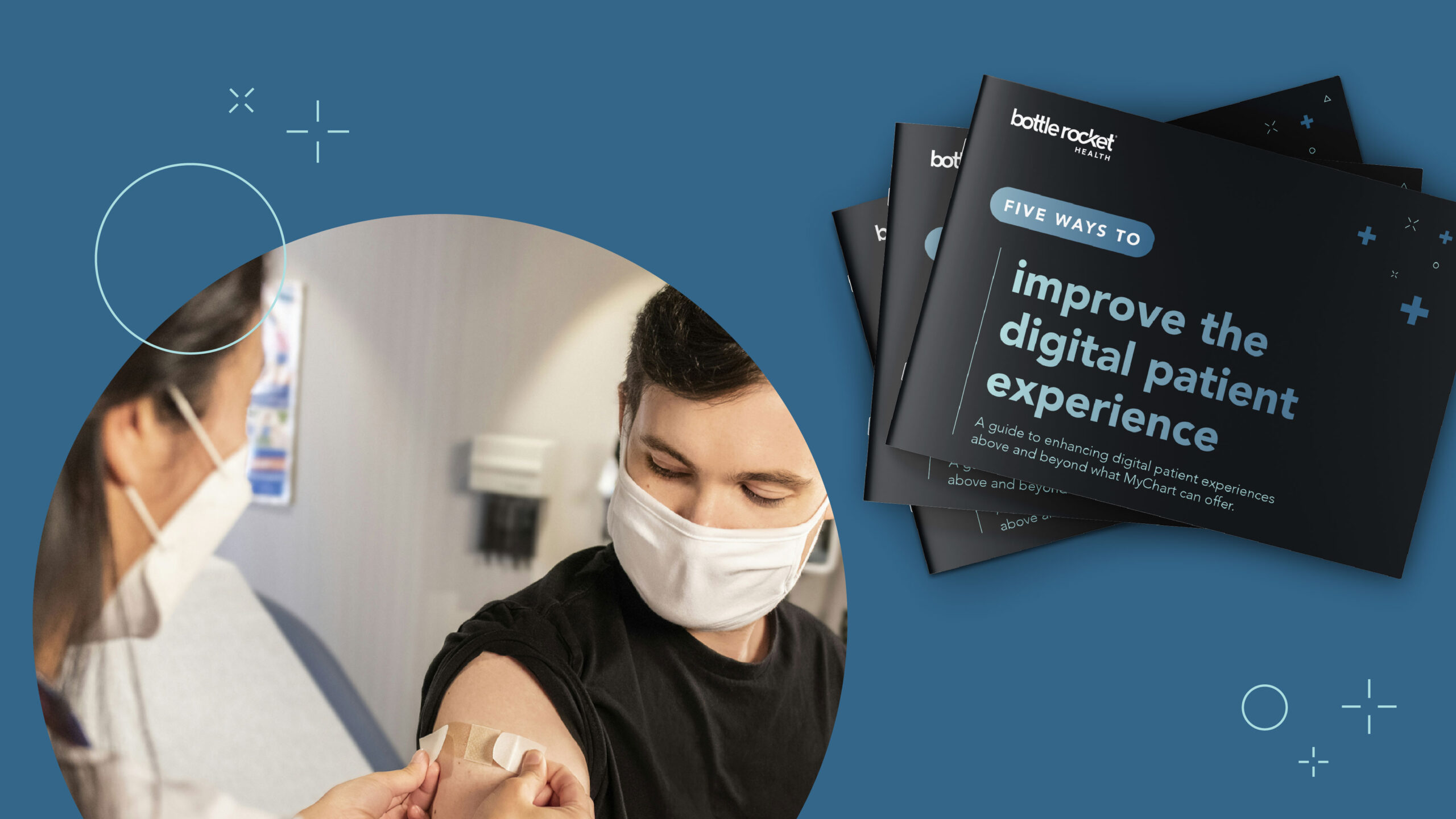Published by
A guide to enhancing digital patient experiences above and beyond what MyChart can offer.
Navigating healthcare as a patient is challenging. Accessing information and communicating with providers through applications like MyChart often proves to be a cumbersome process, especially when contrasted with the ease of digital interactions in other areas of daily life. Booking an appointment with a doctor should be as easy as making a dinner reservation on Resy.
Healthcare providers who successfully simplify this process and create a more user-friendly, seamless patient experience can see enhanced patient satisfaction scores, a rise in appointment bookings, increased patient loyalty, and ultimately, improved patient outcomes. In this guide, we will explore 5 key areas where providers can improve digital patient experiences above and beyond what MyChart offers:
- Fostering Efficiency for Patients and Providers
- Customizing Interfaces for Better Usability
- Unifying Patient Experience
- Building Trust with Patients
- Simplifying Provider Search and Selection
Embark on a journey with us as we delve into the transformative power of digital innovation in patient experience. Discover how custom digital platforms, intuitive patient interfaces, and unified healthcare experiences are not just advancements but essential elements for thriving in today’s healthcare landscape. We’ve helped build and deploy real-world applications of these digital strategies, revolutionizing patient-provider interactions and strengthening loyalty.
Welcome to the new era of healthcare – where digital precision meets patient care, experiences are tailored for individual needs, and every interaction is an opportunity for enhanced engagement and trust.
“Current EHR systems are built for payers, not patients. Care providers who are looking to help elevate the value of EHR for patients need to invest in patient-centric experiences and applications. If they look beyond the off-the-shelf applications the vendors provide, they can use middleware and application programming interfaces (APIs) to build a customer layer that can appeal to patients in general and their own patients in particular.”
Raghid El-Yafouri
Principal Technology Consultant, Healthcare, Bottle Rocket
1 | Fostering Efficiency for Patients and Providers
Efficiency in healthcare processes is a two-way street that benefits both patients and providers. By streamlining tasks such as scheduling, registration, and check-in, healthcare providers can significantly reduce the administrative burden on patients, leading to a smoother and more satisfying healthcare experience.
Clear communication about what patients need to do before an appointment is vital. A patient that hasn’t fasted may have to reschedule a procedure. Enabling patients to complete necessary forms and paperwork digitally before their visit can drastically cut down on waiting times at the office. This not only enhances the patient’s experience by reducing time spent in the waiting room but also streamlines staff workflows allowing them to focus on clinical matters rather than scanning insurance cards and rescheduling appointments.
Real-world data supports the effectiveness of these digital solutions. Healthcare providers who have implemented online pre-appointment processes have reported noticeable reductions in patient waiting times and increased efficiency in patient throughput. An independent study found that by implementing an automated digital check-in process, average patient waiting times were reduced by almost 12 minutes resulting in time savings of 209 hours each month or 2,508 hours a year. This improved efficiency directly translates into more time for patient care and less time spent on administrative tasks.
The benefit of digital efficiency extends beyond the tangible time savings. It also reflects a respect for patients’ time and a commitment to providing a hassle-free healthcare experience which can greatly enhance patient satisfaction and loyalty. And let’s not forget the providers and staff. With record staff shortages efficiency gains must be taken when they are found.
2 | Customizing Interfaces for Better Usability
In today’s digital era, the interface and user experience (UX) of healthcare applications are pivotal in defining patient engagement. A well-designed interface that aligns with your patient’s specific needs can significantly enhance the usability of features in applications like MyChart. For instance, we recently helped a major healthcare provider in Texas overhaul their appointment scheduling interface. By focusing on a more intuitive and visually appealing design, they not only preserved the core functionality but made it more accessible and user-friendly. This change alone led to a notable 60% increase in scheduling activities and 160% increase in conversions, illustrating the direct impact of UX improvements on patient engagement. In addition to improving the existing features, integrating realtime feedback mechanisms can further refine the digital patient experience. This approach allows for continual adjustments based on user interactions, ensuring that the application evolves to meet changing patient needs effectively.
By focusing on developing a custom experience that enhances accessibility and usability without compromising on functionality, healthcare providers can ensure that their digital offerings are not just adequate, but exemplary. This commitment to a superior patient experience will attract new patients and maintain the loyalty of existing ones rather than lose them to one of the ever-increasing number of competitors.
3 | Unifying Patient Experience
A unified digital patient experience transcends mere convenience; it is essential for providing seamless and patient-friendly services. In our fragmented digital landscape where patients often have to juggle multiple apps for different healthcare needs, integrating EHR functionalities (like lab results and appointment scheduling) with external options (like wayfinding and community support) into one cohesive platform can significantly enhance the patient experience and keep them coming back for more.
The challenges posed by disparate systems are not trivial. Patients frequently express frustration when forced to navigate multiple apps, leading to a disjointed experience. A patient checking lab results in one app may not switch to another to schedule a follow-up appointment or find directions to the healthcare facility. Taking away unnecessary roadblocks to getting care unsurprisingly results in better care and better outcomes. A study by PYMNTS and Lynx found that 58% of patients say that a unified digital platform would increase their convenience when managing their treatment and benefits. What’s more, over half of the respondents believed that a unified platform would improve their access to treatment and 41% were interested in having all their healthcare information in one place.
A unified experience also fosters a sense of familiarity and trust. When patients understand that they can access all their healthcare-related services in one place, presented in a language and format they comprehend, it enhances their confidence in the provider. This holistic approach is not just about technology integration; it’s about creating a patient-centric digital environment that mirrors the ease and accessibility of other aspects of their digital lives.
By offering a unified experience, healthcare providers can significantly elevate their levels of digital patient engagement, ensuring they set themselves apart in an increasingly competitive field.
“When it comes to digital experiences, you will naturally look first to your EHR vendor. When you spend 75% of your IT budget with one vendor, it’s natural to want to extract as much value as possible. After all, places like Epic and Cerner convinced providers to spend millions by promising they were a one-stop shop for all their needs. Sure, they offer patient portals that do some things your patients want, but they are largely insufficient and kludgy. Patient interactions require personalization of the experience: both for the provider and for the patient.”
Matt Tobias
Director, Healthcare Practice, Bottle Rocket
4 | Building Trust with Patients
Demonstrating a commitment to the community is a powerful way for healthcare providers to connect with their patients beyond traditional medical care. Trusted, reliable clinical content that resonates with the local community can significantly enhance the digital experience, fostering a deeper connection between healthcare providers and their patients.
Trust is in short supply when someone Googles their symptoms and thousands of options present themselves. Folks can go from having minor shoulder pain to convinced they have cancer shockingly fast when left to navigate the morass of information on their own. Evidence-based, reliable information around common experiences in cold and flu season or easily misunderstood information like vaccination options presented by a local provider is something patients can trust. By integrating this type of content into the digital experience, providers can not only keep patients engaged, but have them return for more each time they have a question.
The impact of adding trusted content to a digital platform can be measured in increased patient engagement. We helped one customer increase their Monthly Active Users by 34% when they integrated content from their own clinicians alongside other continuous improvements into their digital patient experience.
By providing proven, relevant clinical content to those seeking information, healthcare providers can create a more engaging and meaningful digital experience for their patients, which in turn fosters loyalty and trust.
5 | Simplifying Provider Search and Selection
The journey to receiving quality healthcare begins with finding the right provider, a process that can be significantly enhanced through a well-designed digital experience. Providing patients with comprehensive information about providers, including star ratings, recommendations, locations, and personalized bios, can facilitate a more informed and confident choice.
In the digital age, most patients turn to online resources to research and select their healthcare providers. A recent survey by Tebra found that three out of four people search online for information and reviews on doctors, dentists, or medical care, especially when looking for new healthcare providers. A custom digital platform that integrates detailed information about providers (including specialties, patient reviews, qualifications, and personalized bios) empowers patients in their decision-making process. This transparency not only builds trust but also helps patients feel more connected to their chosen healthcare professionals.
When patients have access to detailed provider profiles, there is a noticeable increase in appointment bookings and patient satisfaction. One healthcare organization we worked with was able to achieve a 10% conversion rate for booking appointments via their mobile experience when they added detailed provider profiles: double the industry average of 5%. Patients appreciate the ability to find all the necessary information in one place, making the process of choosing a provider less daunting and more straightforward.
Incorporating comprehensive provider information into the digital patient experience does more than just streamline the process of finding a healthcare professional; it also demonstrates a commitment to transparency and patient empowerment. By providing patients with all the information they need to make an informed decision, healthcare providers can foster a stronger, more trusting relationship with their patients.
Your Partner in Digital Healthcare Innovation
By their nature Epic and other EHR vendors aren’t in the business of helping healthcare providers customize their digital patient experience. It’s easy to feel like you’re on your own when this realization strikes. Unfortunately, attempting to differentiate or improve digital patient experiences above and beyond MyChart is not something Epic supports. Fortunately, Bottle Rocket Health can be with you every step of the way to do all this and more. You are not on your own. Together, we will make that happen.
At Bottle Rocket Health, our mission is to propel healthcare providers into a digitally advanced future. Whether it’s through developing intuitive and user-friendly patient interfaces, integrating seamless and comprehensive digital healthcare platforms, or implementing data-driven strategies for smarter decision-making, our team at Bottle Rocket Health is adept with the technology and knowledge to take your healthcare organization to the next level. By partnering with us, you can ensure that your digital patient experiences are not just on par with, but surpass the offerings of standard platforms like MyChart. Let’s work together to make your healthcare services not just a necessity, but a digitally enriched experience that resonates with every patient.
Download your copy today.
To learn more, visit us at bottlerocketstudios.com/expertise/healthcare or drop us a note at [email protected].
Share:
Categories
tags
Related Posts

The Value of Agency Project Managers

Your Guide to a Product Analytics MVP


